
 Jewish Homeowners and
Businesses in 1939
Jewish Homeowners and
Businesses in 1939 
The map above is from the book, and is based on a map from 1900 which was updated in 1939.
Legend: 1-2. Town Hall (Ratusz Miejski), County Starost 3. High
School for men (Gimnazjum) 4. Monastary and Church "Franciszkanch"
5. Sports Society "Sokol" 6-7. Schools 8. Synagogue 9.
Chapel 10. Hospital 11-12-13. Bank,County Council, Savings Society
14-15-16. Post Office, Regional Court, Power Station 17-18.
Dormitory, Railway Station 19. Monastary and Church "Wizytek"
20-1. Monuments 22. School 23. Cemetary Chapel 24. Gas
Station/glassworks 25. Townsfolk Association - performance Hall
26. Football Stadium
The following was extracted from the list of owners of homes, and their addresses, in 1939. If there are two names given, the first is that of the owner of the property, the second of the tenant. The numbers at each street are actual street numbers, but few match the current ones. "N" with a surname means "name unknown and Ulica means Street.
The lovely photograph to the right is
the well known Synagogue 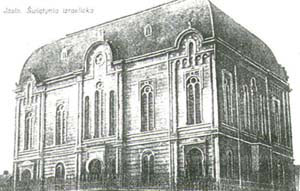

Before Monika Hendry gave us a first hand impression (see
below), the only source material we had was the Jaslo Cemetery
Survey, completed in 1992 by the US Commission (#POCE000724).
The following is adapted from their report:
The cemetery is on Florjanska Street. The cemetery was used by
Orthodox, and Progressive-Reform. It is located in a urban
area, on flat land, isolated from the rest of town. Access off
a public road is entirely closed. It is marked by a plaque in
Polish referring to Jews and by Jewish symbols on gate or
wall. There is a continuous masonry wall and a locked gate.
One third of a hectacre in size, there are between 20 to 100
gravestones, not in their original locations; 50%-75% are
toppled or broken. The location of stones removed from the
cemetery is not known. Tombstones are datable from both the
19th and 20th centuries. The stones, inscribed in Hebrew and
Polish, are made of marble, granite, sandstone and concrete of
all shapes, some smooth and inscribed, some flat with carved
relief decorations, some sculpted. There are marked and
unmarked mass graves and special memorial monuments to
Holocaust victims but no other structures.
The present owner is the municipality but the property is used
only as a Jewish cemetery. Properties adjacent to the cemetery
are residential. The cemetery is visited occasionally by both
Jewish and non-Jewish private visitors.
The cemetery is known to have been vandalized during World War
II. The gate was repaired and cleaning the stones and removing
vegetation was carried out by local/municipal authorities.
Vegetation disturbing the graves is a constant problem,
weather erosion a moderate threat, security and pollution a
slight threat.
Next received was the following comment was made by a visitor in 1997: "The cemetery is located on Ulica Florjanska, opposite house Nr.85. It is well-groomed. A new memorial reminds of holocaust. We could not find a sign of the former WWI military graves."
Then Monika Hendry sent us wonderful photographs and her
impressions:
Until very recently there was a broken little water pump at
the corner (turning off the main road to the cemetery) for
visitors to wash their hands. I remember my g-mother saying
that Jews would always wash their hands before entering the
cemetery.
Monika's first task was to locate the key. She found out that
the key is held by the director of the Dom Kulturi.
Monika wrote: "The cemetery, viewed from the padlocked gate,
is overgrown and unkempt: reminded me of the lawn surrounding
a haunted house. I used to climb over the wall. There's a new
pavement leading to the gate but it is already overgrown.
Monika sent these photographs.......so let's begin with the
first view of the cemetery................ 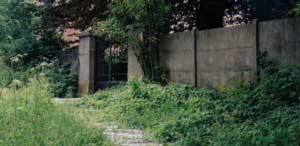 and go to the wonderful gate.....
and go to the wonderful gate.....
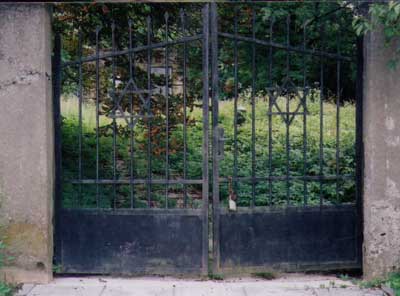
Monika: It is a jungle inside. It is actually quite dangerous
to walk around because of all the toppled tombstones and
ditches covered by the undergrowth.The irony is that the
tombstones of the rich made of marble and basalt were removed
very early on, right after the war by a Polish stone
mason....so the very 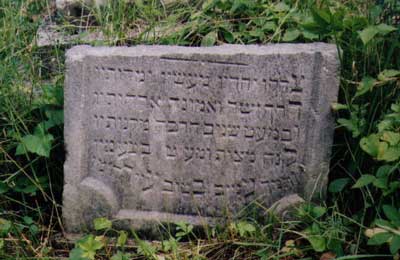
few graves that remain are presumably of poor people and as
such were not attractive. There are a few very new ones which
all name people killed by Germans. They look like they were
put very recently.
These are original stones that I saw:

(Editor) Bill Leibner has done some explanation and
translation for us, as follows:
The tombstone above which is broken is an interesting one.The
name is not mentioned directly since this was not the custom
in those days. They therefore took each letter and found a
line in the holy writtings that started with the letter. You
have the following letters; tz, d, vav, and kof which stands
for Tzadok (righteous), a typical Hebrew first name. The last
name is represented by the last line Weber. Thus the stone is
for Tzadok Weber.
The stone immediately above on the right is a stone for a
woman. You can see the candelabra, symbol of lighting candles,
usually done by women on Friday and the evening before
holidays. You also see the letters P.T.that stand for "here is
buried"... Unfortunately the foliage covers the important
details.
The following current photographs of the Jaslo Cemetery were
taken off the Polish Cemetery Web site
http://www.kirkuty.xip.pl/jaslo.htm 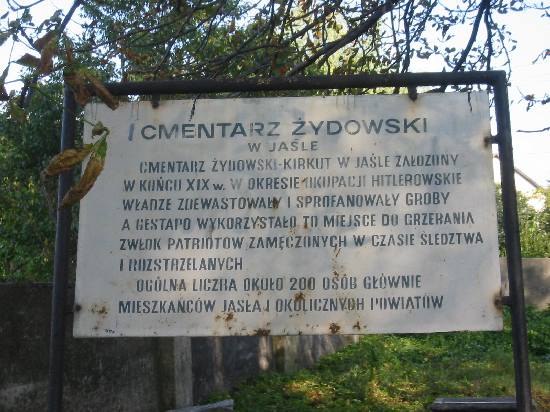


 Monika also
found this article in the "Jaslo News" dated 3 August 1894; it
said "we can see that the Jewish commune holds the ashes of
their dead in higher respect than Catholic people, whose
cemetery lies on the river (Jasiolka), and is flooded whenever
the water rises even a little. We don't have a swimming pool
when we are alive so we can enjoy it when we are dead free of
charge".
Monika also
found this article in the "Jaslo News" dated 3 August 1894; it
said "we can see that the Jewish commune holds the ashes of
their dead in higher respect than Catholic people, whose
cemetery lies on the river (Jasiolka), and is flooded whenever
the water rises even a little. We don't have a swimming pool
when we are alive so we can enjoy it when we are dead free of
charge".
These sarcastic comments from a journalist were prompted by
the fact that Jaslo's Catholic cemetery, set up in 1790, was
right next to the river and frequently flooded, while the
Jewish kehilla purchased a nice elevated site on the border of
Jaslo and the village of Sobniow (now Jaslo suburb).
"In Jaslo we stayed two days and met Magda Bialec, a teacher
of Polish literature in one of the Jaslo high schools. Magda
is special ! With Maciek her husband, also a teacher, Magda
has decided that the young generation of Jaslo, her students
aged 14/18 must know about their past history as they are
citizen of Jaslo, and the main thing that these students
should know about their past, is about Jaslo Jews.
Magda explains: “I lead young people to the Jewish cemetery,
to teach them about their memory - They often do not know that
such a place exists, but they come “Voluntarily and out of
curiosity”. 
Upon my arrival, Magda took me to the Jewish cemetery, with my
friends; the place was in shambles full of weeds; she
apologized, explaining that there used to be a benevolent
gardener, but that he had died. In the same sentence she told
me that she had decided to clean up the place with her
students; she did so in June 9, 2017; a few days after this
this first "hand" cleaning, she was able to receive two new
mowers from us, she bought via a donation that I made with a
few friends and family members to the Antyschematy2
foundation, which is based in Tarnow.
Objectives of the Antyschematy2 Foundation
 Editors note: see the Facebook sites for
this Foundation at https://www.facebook.com/antyschematy2/ and
https://www.facebook.com/pg/antyschematy2/photos/?ref=page_internal
. The photos are from these Facebook pages.
Editors note: see the Facebook sites for
this Foundation at https://www.facebook.com/antyschematy2/ and
https://www.facebook.com/pg/antyschematy2/photos/?ref=page_internal
. The photos are from these Facebook pages.
Magdalena Bialek is glad that she is doing what she does and
supporting the youth. She argues that the present  generation is less stereotyped - they are eager to build their
image of the world in the face of authentic experience. This
is the attitude of the young generation who says: I myself
want to see how it works - she emphasizes. And why the
cemetery? - I ask. - Because this is a material proof of the
existence of the Jewish community in Jaslo, she explains. -
And for the youth, the place where their work changes
something. The adjoining area around the foot of the monument,
the candlelight, are small things, but great at the same time.
And besides, it triggers questions for them to ask to
themselves and to others - she explains.
generation is less stereotyped - they are eager to build their
image of the world in the face of authentic experience. This
is the attitude of the young generation who says: I myself
want to see how it works - she emphasizes. And why the
cemetery? - I ask. - Because this is a material proof of the
existence of the Jewish community in Jaslo, she explains. -
And for the youth, the place where their work changes
something. The adjoining area around the foot of the monument,
the candlelight, are small things, but great at the same time.
And besides, it triggers questions for them to ask to
themselves and to others - she explains.
Where are we today: I have a list of 20+ friends and family members who want to support Magda She has decided that there will be a commemoration of the deportation of the Jaslo Jews every year on August 17th. This day marks the deportation of the jews to Belzec. She would like to make the Jewish cemetery a place of visit and commemoration. She wants to digitalize the list of people, she can identify buried in the cemetery. She has made an agreement with the Antyschematy2 foundation in order to be able to collect funding secured through Visa/Paypal via the foundation's web site.
Why Jewish Cemetery? Nowadays, we increasingly feel the need to discover and understand our past, the cultural heritage left by our ancestors. Due to the huge amount of damage that Jaslo suffered as a result of World War II, there were not many material memories of the past. What has been saved, the historical and cultural heritage of the former inhabitants, we try to protect and surround with care.
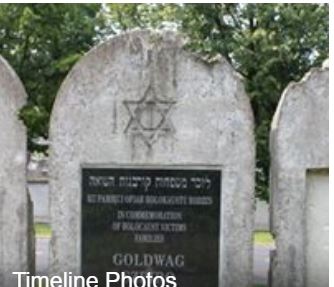 Jasielski Jewish Cemetery is the
only material trace of the presence of the Jewish community in
Jaslo. Like every other cemetery, this is also a monument to
the history of our city. Thieves, ordinary people, inhabitants
of thriving social, economic and political life, which ended
the Second World War, are buried there. It is the cultural
heritage of Jaslo, which we want to take care of and give to
the next generations.
Jasielski Jewish Cemetery is the
only material trace of the presence of the Jewish community in
Jaslo. Like every other cemetery, this is also a monument to
the history of our city. Thieves, ordinary people, inhabitants
of thriving social, economic and political life, which ended
the Second World War, are buried there. It is the cultural
heritage of Jaslo, which we want to take care of and give to
the next generations.
The cleaning of the cemetery was the next action taken in the year (after Memorial Day) The Holocaust Victims exhibition, called the "Jewish Community in Jaslo" and held in the Regional Museum in Jaslo" the action called " Daffodils ", a social and educational campaign, which includes the Public Library in Jaslo, are aimed at restoring the image of the Jewish community and its role In the life of our city. Due to unregulated legal status and ongoing court proceedings, the cemetery has no formal guardian. Tombstones are covered with lush grass and hidden beneath a layer of branches and leaves, often accumulated over many years. At present the cemetery is taken care of by a private initiative from the school environment with a group of young people. Their actions are minimal, they mainly involve keeping the monument clean or harvesting leaves from the path. The amount of cleaning work needed to do in the cemetery, due to its surface, remains huge.
We will soon get information on how to donate to this wonderful project. Stay tuned!
Just in case you get to Yaslo, you may want to find the
cemetery....you'll 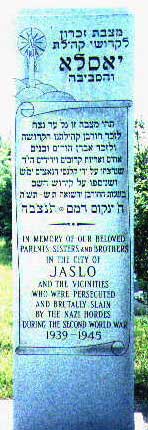 find it on the bottom right hand corner of the map at the top
of this
find it on the bottom right hand corner of the map at the top
of this 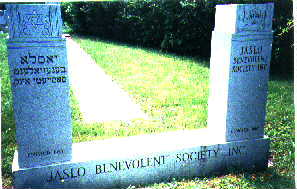 page.....but if you
cannot get to Yaslo, you may want to visit one of the
Landsmanshaften cemeteries in New Jersey.........
page.....but if you
cannot get to Yaslo, you may want to visit one of the
Landsmanshaften cemeteries in New Jersey.........
Up until 2019, Phyllis Kramer (OBM) developed and maintained this KahilaLink. Phyllis did a wonderful job documenting and sharing information about this shtetl. Starting in July 2021 Jeff Alexander is trying to fill Phyllis’ shoes. Please contact Jeff Alexander for anything related to this shtetl.
Return to Krosno's Table of
Contents
Return to Jaslo's Table of
Contents
Copyright © (2022) Jeffrey Alexander. All rights
reserved.